How do you hit all the right marks for a cozy mystery that keeps readers guessing? This Cozy Mystery plot template will help. Fill in the gaps while creating a story designed to keep your fans turning pages faster than Jessica Fletcher stumbled over bodies in Cabot Cove.
What is the Cozy Mystery Plot Structure?
The plot structure of a cozy mystery starts with the characters. The genre typically features an amateur sleuth as the protagonist (usually a woman) with a career that gives her access to gossip or information not available to others (e.g., an innkeeper or shop owner). Most cozy mysteries are set in small towns that hold a deep sense of community.
While the crimes in these novels include murder, arson, extortion, kidnapping, and sabotage, there’s no on-page violence, sex, or swearing. The protagonist does get into a spot of trouble now and then, but it’s never anything overly dark or destructive.
Who is the Cozy Mystery Plot Structure For?
All writers of cozy mysteries will find this plot structure helpful. Pantsers can use it as a basic outline without filling in all the beats, while plotters will be able to add as many scene notes as they’d like.
Mystery fans often point to Agatha Christie as the first cozy mystery author. Other contemporary authors with popular series in this genre include Kate White, Laura Childs, Victoria Thompson, and Joanne Fluke. Many cozy mystery authors create series based on their protagonists’ professions, such as:
- The Gray Whale Inn series by Karen MacInerney
- The Paws and Claws series by Krista Davis
- The Blue Ridge Library series by Victoria Gilbert
- The Knit & Nibble series by Peggy Ehrhart
Plot Points of the Cozy Mystery Plot Structure
The Cozy Mystery Beat Sheet template in Plottr has two distinct sections, which can overlap on the timeline: Plotlines and Scene Cards (which are designed to accommodate approximately 20 beats or chapters).
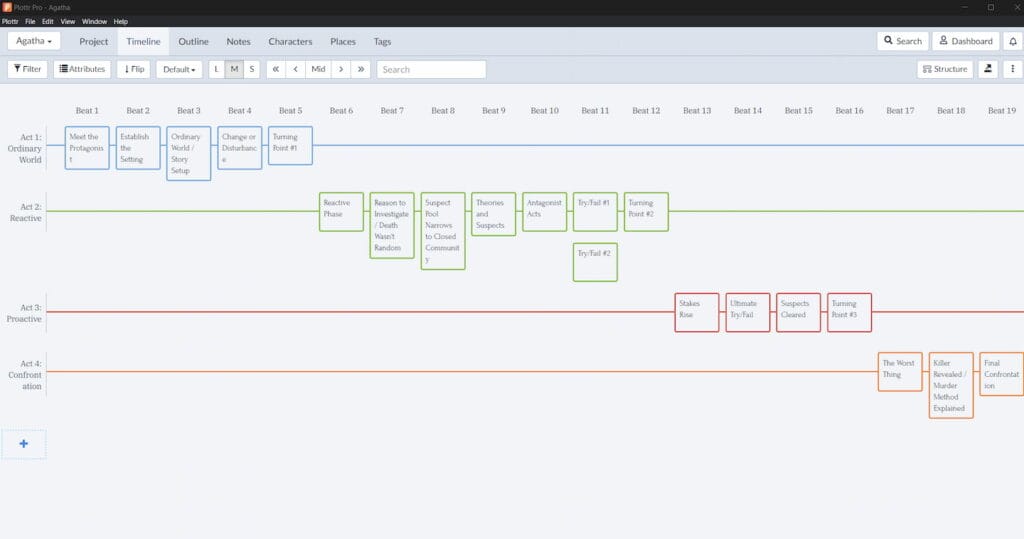
We’ll take a closer look at these below, starting with plotlines. There are four overarching acts in the Plotlines section. These will be used to paint the general picture of your story.
Act 1: Ordinary World
In this section, you’ll give readers a glimpse into the life of your protagonist and the ordinary world she inhabits.
Act 1 will contain roughly the first five chapters from your scene cards (we’ll get to those in a minute!).
It contains these scene cards by default:
- Meet the Protagonist
- Establish the Setting
- Ordinary World/Story Setup
- Change or Disturbance
- Turning Point #1
Example: For the ‘Meet the Protagonist’ section, you could write a bullet point summary of your protagonist.
For Agatha Christie’s A Pocketful of Rye, featuring Miss Marple, for the ‘Meet the Protagonist’ section we could write:
- Introduce Miss Marple, an elderly but sharp-witted lady with a notion about blackbirds
- Her external goal is to find out who killed her former maid, Gladys Martin
- Her internal goal is to stop an evil killer
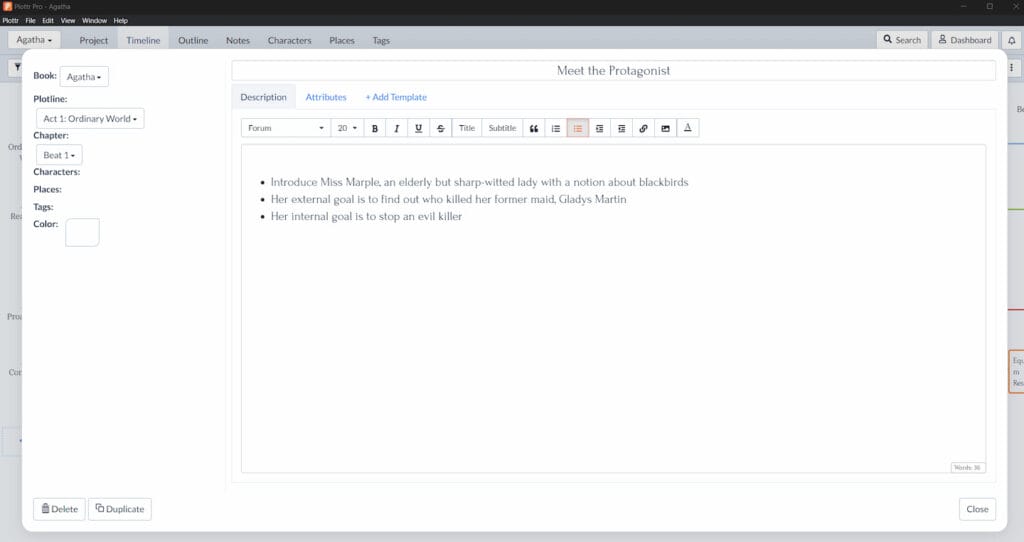
Act 2: Reactive
This is when something pushes your protagonist to investigate the crime.
This part of your book will run, approximately, from chapters 6 through 12, and feature a lot of conflict and setbacks.
It contains these scene cards:
- Reactive Phase
- Reason to Investigate/Death Wasn’t Random
- Suspect Pool Narrows to Closed Community
- Theories and Suspects
- Antagonist Acts
- Try/Fail #1 and Try/Fail #2
- Turning Point #2
Act 3: Proactive
Your protagonist encounters even more trouble in this section as the stakes rise and she scrambles to figure things out.
Your sleuth will likely make false assumptions about someone’s guilt and overlook the real culprit. Act 3 runs from chapters thirteen to sixteen and contains these scene cards:
- Stakes Rise
- Ultimate Try/Fail
- Suspects Cleared
- Turning Point #3
Act 4: Confrontation
This is the final part of the book, where your heroine will finally figure everything out. She will have her light bulb moment, which will probably put her in danger from the true suspect, but she’s rescued (or rescues herself) and the culprit is apprehended.
The scene cards for this act are:
- The Worst Thing
- Killer Revealed/Murder Method Explained
- Final Confrontation
- Equilibrium Restored
Using the Cozy Mystery Beat Sheet Template’s Scene Cards
Now we move onto scene cards. These will help you craft your cozy mystery.
We give you 20, but you can break these into more or fewer chapters, depending on your story.
Meet the Protagonist
This is where we introduce the reader to your hero or heroine and learn what he or she wants (these are the external and internal goals).
Some mysteries, particularly those from the Golden Age (think Agatha Christie and Dorothy Sayers), don’t have internal goals for their heroes, so you can skip that if you’d like.
Your protagonist’s goals will give you ideas for roadblocks to prevent and challenge her from meeting those goals.
Reason to Investigate/Death Wasn’t Random
This happens in Act 2, after the initial introduction to the setting, crime/death, and protagonist.
You’ll establish two things here: why your sleuth is investigating the crime and that the crime wasn’t random. Reasons your protagonist might be invested in figuring out whodunit could include discovering the body, a close family member or friend being named as a suspect, or her observations that the investigator isn’t competent.
Cozy mystery readers want to solve the puzzle, so remember: no random crimes. You’ll need to give your culprit a real reason for having committed this one.
Ordinary World/Story Setup
Cozy mysteries take place in small locations, not big cities. To hit the right tone for setting, consider small towns, close-knit communities, and quaint villages.
Other ways to create the right tone include setting your story on a college campus, around a flower or bakery shop, at a museum, or on a cruise ship.
Change or Disturbance
You’ll need to use this scene to show the reader something isn’t right while dropping hints of a murder or crime to come.
Examples include threatening letters, missing people, and characters not behaving in their usual manner.
Turning Point #1
A turning point sends the story in a different direction.
The end of Act 1 for cozy mysteries often involves the discovery of a dead body or the lead’s decision to investigate the central crime. The turning point should be drastic enough that your heroine cannot return to ordinary life until she solves the problem.
Reactive
With amateur sleuths as protagonists, usually there needs to be a gradually more elaborate involvement in the investigation as they figure out suspects and decipher clues.
During Act 2, the heroine is more reactive to the plot thickening before her as she stumbles along her path, trying to find answers.
Reason to Investigate
Unlike a law enforcement officer, your protagonist will need a good reason to stick her nose into solving the crime.
Take some time to establish this detail, as it will lend credibility to the story and plant seeds for future plot and character development.
Suspect Pool Narrows to Closed Community
As your protagonist conducts her investigation, her suspect pool becomes limited to a small group based on things like the crime’s window of time, points of access to the murder weapon, or the confines of bad weather.
Often this narrowing puts someone the protagonist cares for (family, friends, a potential love interest) on the suspect list.
Theories and Suspects
At this point, the heroine is collecting a ton of information — some red herrings, some real clues. She’ll use these to develop theories about how the crime was committed and who could have done it.
Antagonist Acts
Because of the sleuth’s progress in solving the crime, the villain becomes nervous and takes action to stop the heroine from moving forward in her investigation.
This could come in the form of false clues, framing someone else, or pressuring officials to close the case prematurely.
Try/Fail #1 & Try/Fail #2
Next, the protagonist tries to identify the murderer — but falls short of the truth. This can happen several times as necessary for the story.
If your sleuth’s first suspect is cleared definitively, then the heroine will switch to another suspect and go through the try/fail process again.
Turning Point #2
As the story moves toward the finish line, something happens to make the sleuth reevaluate everything she’s learned to this point. This often involves the death of a major suspect, which means the protagonist must reassemble the puzzle she had been creating.
Stakes Rise
This happens for both the protagonist and the antagonist. Often a second murder is committed and the heroine feels pressure to solve the crimes.
The protagonist becomes more proactive in seeking justice.
Ultimate Try/Fail
The heroine now comes to yet another theory about what happened, but this time, she misses the mark in a rather spectacular way.
For example, she could publicly accuse someone, only to be told the police have cleared the person.
Suspects Cleared
As she’s testing theories, the protagonist is able to clear some of her original suspects from her list. The scope of who the villain really is begins to narrow.
Turning Point #3
This is when the final conflict will be set into motion — often the discovery of a clue or new information that reveals the true murderer’s identity.
The Worst Thing
This is the lowest point of your story.
Your protagonist might believe the murderer will escape justice, or key evidence pointing to the villain’s guilt disappears. But you’ll use the low point to help your heroine reassess her goals and desires — or she may realize she’s on the right track and become more determined to see justice served.
Killer Revealed/Murder Method Explained
At the final confrontation, you’ll reveal the killer. But the solution to your puzzle needs to be clear and dramatically delivered. Make sure these questions are answered for the reader:
- Who committed the murder
- How the murder was committed
- How the protagonist figured it out (what clues unlocked the mystery)
- Explain any red herrings, if needed
Final Confrontation
Your heroine could be in physical danger or it could be a battle of wits. She can confront the villain directly on purpose, be forced into the confrontation by another, or surprised by the antagonist.
Equilibrium Restored
Justice is now served with the revelation of the murderer’s identity. You’ll need to have the murderer arrested and give readers a vision of a healthy community at the end of the book.
Clear up any lingering questions about the crime here, too. If your book is part of a series, consider providing a hint at what will happen in the next installment.
How Do You Use the Cozy Mystery Plot Structure in Plottr?
First, make sure that you have an active Plottr membership plan or sign up for a free trial.
Then, to use the Cozy Mystery Beat Sheet template in Plottr:
- Step 1: From the Plottr dashboard, select Create from Template
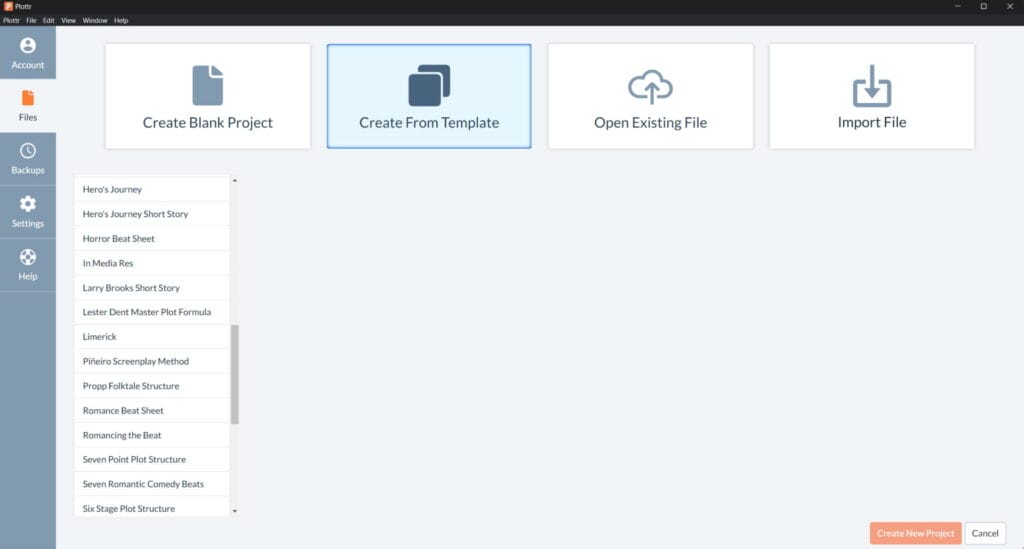
- Step 2: Scroll to the template Cozy Mystery Beat Sheet, select it, then choose Create New Project
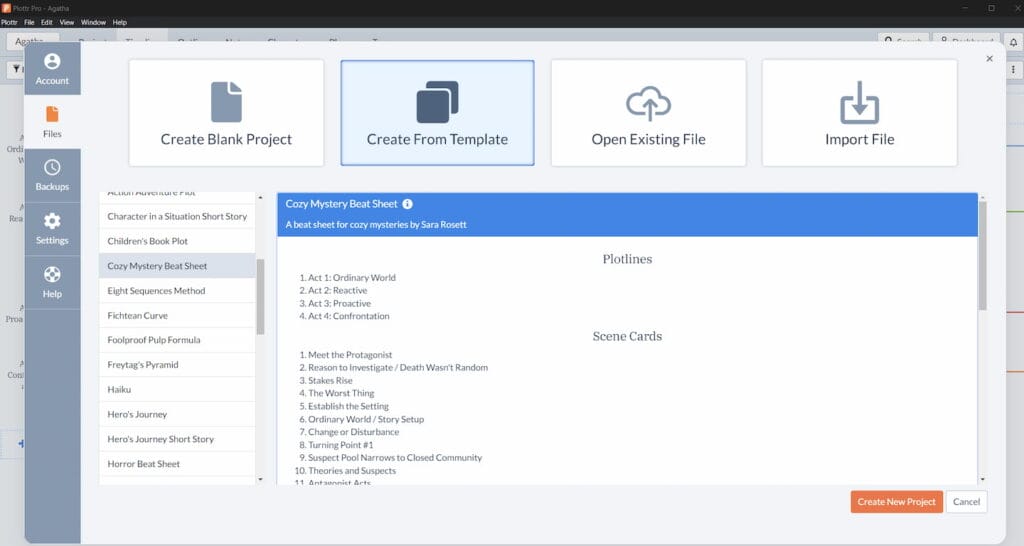
- Step 3: You will see story beat cards in a plotline. Hover over a card to see its contents, and click a card to begin adding your own ideas
Pro tip: Click the M in the top navigation to fit most of the cards on one screen if you don’t want to scroll horizontally much (you can switch back to the expanded view by clicking L).
- Step 4: Fill out the beat cards and add your ideas above the guidelines if you want to keep them, or simply replace/erase them
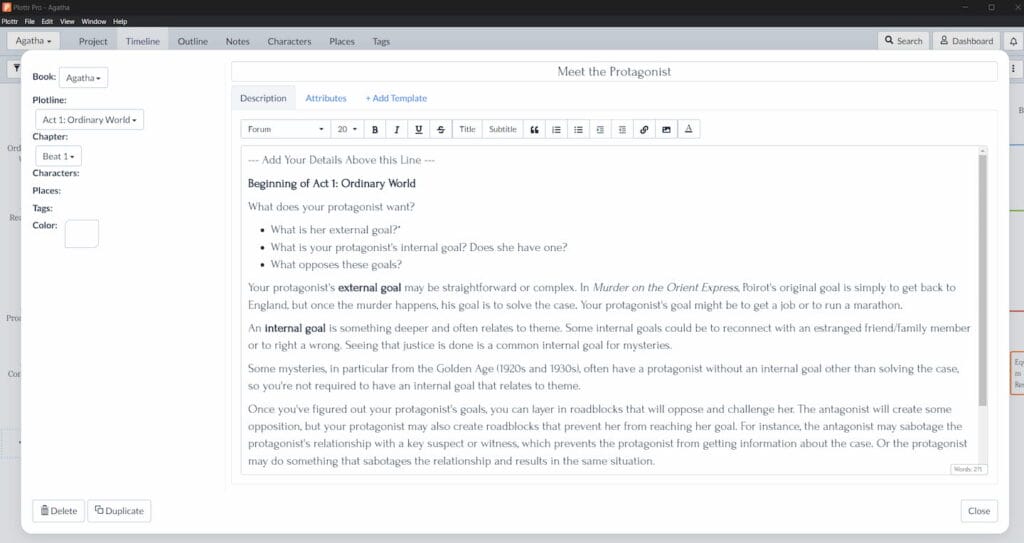
And there you have it. If you want to create subplots, the cozy mystery beat sheet template works well with these other plot and character templates in Plottr:
Cozy Up and Get Plotting
Ready to try your hand at writing a cozy mystery? Check out the template in Plottr to get started. Sign up for a free trial if you’re not already using Plottr, and let us know your thoughts below in the comments!






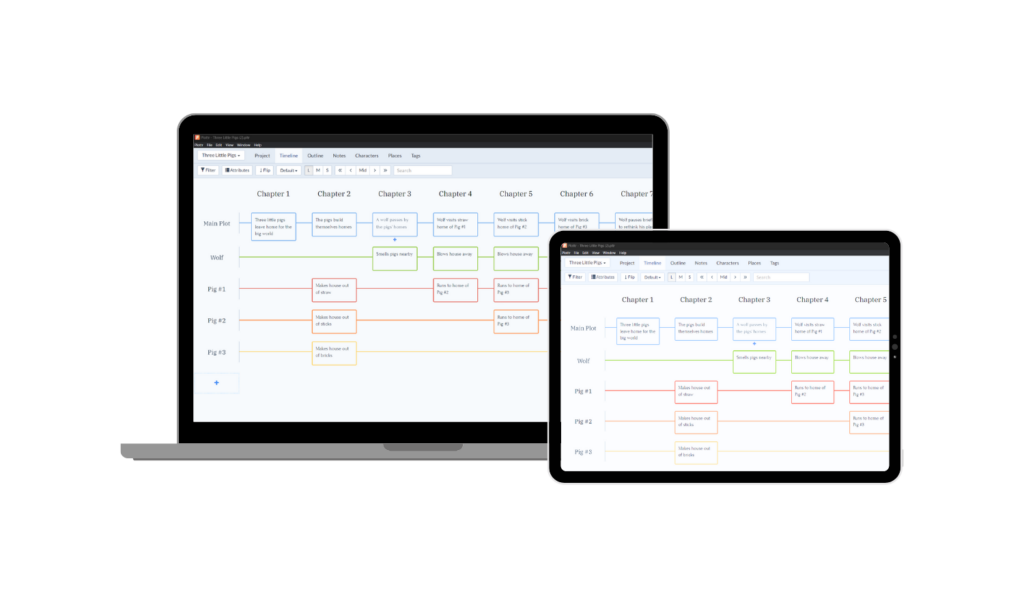
2 thoughts on “Cozy Mystery Plot Template: Create Clues Like Dame Christie”
Thank you for this! I don’t find much useful information about cozy plotting online. I’ve bookmarked this for future use.
It’s a pleasure, Kestrel! We’re glad you found this Plottr template guide useful. Thanks for sharing your feedback with us.